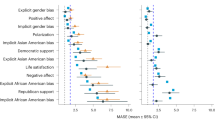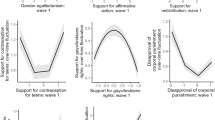Abstract
Many discussions, academic and otherwise, implicitly assume that public opinion changes because opinions change. This ignores the possibility that public opinion changes because publics change. In this paper I show how, by modifying existing component-difference methods, the proximate sources of societal change - actual individual change versus change in publics (turnover) - can be separated using repeated survey data. The method is applied to change in gender role attitudes in the United States, using 1972–1988 data from the General Social Surveys. Both components have contributed substantially to the trend away from traditional attitudes. Yet there is an important difference: Population turnover has contributed steadily to the trend, whereas the contribution of individual change has been erratic from survey to survey.
Similar content being viewed by others
References
Alexander, J., Geisen, B., Munch, R. and Smelser, N., eds. (1987). The micro-macro link. Berkeley: University of California.
Barnett, L. (1991). Societal reflections in legal thought: A macro-sociological approach to jurisprudence. Unpublished manuscript, Widener University.
Cherlin, A. and Walters, P. (1981). Trends in United States men's and women's sex-role attitudes: 1972 to 1978, American Sociological Review 46:453–60.
Coleman, J. S. (1986). Social theory, social research, and a theory of action, American Journal of Sociology 91:1309–35.
Collins, R. (1981). On the microfoundations of macrosociology, American Journal of Sociology 86:984–1014.
Das Gupta, P. (1978). A general method of decomposing a difference between two rates into several components, Demography 15:99–112.
Davis, J.A. (1975). Communism, conformity, cohorts, and categories: American tolerance in 1954 and 1972–73, American Journal of Sociology 81:491–513.
Davis, J.A. (1980). Conservative weather in a liberalizing climate: Change in selected NORC general social survey items, 1972–78, Social Forces 58:1129–56.
Davis, J.A. and Smith, T.W. (1988). General social surveys, 1972–1988 (MRDF). Chicago: NORC (Distributed by Roper Public Opinion Research Center, New Haven, Conn.)
Davis, K. (1984). Wives and work: The sex role revolution and its consequences, Population and Development Review 10:397–417.
Davis, K. and Oever, P. van den (1982). Demographic foundations of new sex roles, Population and Development Review 8:495–511.
Durkheim, E. (1938). The rules of sociological method. Glencoe, IL: Free Press [First published in 1895].
Firebaugh, G. (1989). Methods for estimating cohort replacement effects, in: C. Clogg (ed.), Sociological methodology 1989. Oxford: Basil Blackwell.
Firebaugh, G. (1992). Ryder's theory of demographic transition and social change. Unpublished paper, Department of Sociology, Pennsylvania State University.
Firebaugh, G. and Davis, K. E. (1988). Trends in antiblack prejudice, 1972–1984: Region and cohort effects, American Journal of Sociology 94:251–72.
Firebaugh, G. and Harley, B. (1991). Trends in US church attendance: Secularization and revival, or merely lifecycle effects?, Journal for the Scientific Study of Religion 30:487–500.
Giele, J. (1989). Gender and sex roles, in: N. Smelser (ed.), Handbook of sociology. Newbury Park, CA: Sage.
Glenn, N. (1980). Values, attitudes, and beliefs, in: O. Brim Jr. and J. Kagan (eds.), Constancy and change in human development. Cambridge: Harvard.
Huber, J. (1990). Macro-micro links in gender stratification, American Sociological Review 55:1–10.
Kitagawa, E. (1955). Components of a difference between two rates, Journal of the American Statistical Association 30:1168–94.
Mannheim, K. (1952). The problem of generations, in: Essays on the Sociology of Knowledge. London: Routledge and Kegan Paul[First published in 1927].
Mason, K., Czajka, J. and Arber, S. (1976). Change in US sex-role attitudes, 1964–1974, American Sociological Review 41:573–96.
Mason, K. and Yu-Hsia, Lu (1988). Attitudes toward women's familial roles: Changes in the United States, 1977–1985, Gender and Society 2:39–57.
Norpoth, H. (1987). Under way and here to stay: Party realignment in the 1980s?, Public Opinion Quarterly 51:376–91.
Plutzer, E. (1988). Work life, family life, and women's support of feminism, American Sociological Review 53:640–49.
Powell, B., and Steelman, L. C. (1982). Testing an undertested comparison: Maternal effects on sons' and daughters' attitudes toward women in the labor force, Journal of Marriage and the Family 44:349–55.
Ryder, N. (1965) The cohort as a concept in the study of social change, American Sociological Review 30:843–61.
Smith, A.W. (1985). Cohorts, education, and the evolution of tolerance, Social Science Research 14:205–25.
Spitze, G. and Huber, J. (1980). Changing attitudes toward women's nonfamily roles: 1938 to 1978, Sociology of Work and Occupations 7:317–35.
Stouffer, S. (1955). Communism, conformity, and civil liberties. New York: Doubleday.
Thornton, A. (1989). Changing attitudes toward family issues in the United States, Journal of Marriage and the Family 51:873–93.
Thornton, A. and Freedman, D. (1979). Changes in the sex role attitudes of women, 1962–1977: Evidence from a panel study, American Sociological Review 44:831–42.
Thornton, A., Alwin, D. and Camburn, D. (1983). Causes and consequences of sex-role attitudes and attitude change, American Sociological Review 48:211–27.
Author information
Authors and Affiliations
Rights and permissions
About this article
Cite this article
Firebaugh, G. Where does social change come from?. Popul Res Policy Rev 11, 1–20 (1992). https://doi.org/10.1007/BF00136392
Issue Date:
DOI: https://doi.org/10.1007/BF00136392




